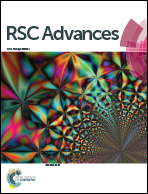Efficient catalytic conversion of lignocellulosic biomass into renewable liquid biofuels via furan derivatives†
Abstract
Efficient production and sequential utilization of furan derivatives will provide a promising approach towards achieving renewable liquid biofuels from biomass. This study aims to investigate the simultaneous production of furfural and 5-(hydroxymethyl)furfural (HMF) from biomass and further upgrade them into biofuels. Firstly, furfural and HMF are obtained together with high yields from a mixture of C5 (xylose) and C6 (glucose) sugars, or from lignocellulosic biomass, such as birch, cornstalk, pine, bagasse, and poplar in a tetrahydrofuran (THF)/H2O–NaCl biphasic system under mild conditions. The co-existence of C5/C6 sugars or impurities in lignocellulosic biomass has little influence on the simultaneous production of furfural and HMF. Then, the generated furfural and HMF in the upper organic phase are directly used as substrates without extra separation and purification processes, and efficiently upgraded to 2-methylfuran (MF) and 2,5-dimethylfuran (DMF), both of which are considered as promising renewable liquid biofuels with high-energy content. Hence, the seamless integration of lignocellulosic biomass into renewable liquid biofuels will accelerate our society moving towards a renewable transportation economy by utilizing cheap feedstocks, mild reaction conditions, and cost saving in separation and purification.


 Please wait while we load your content...
Please wait while we load your content...